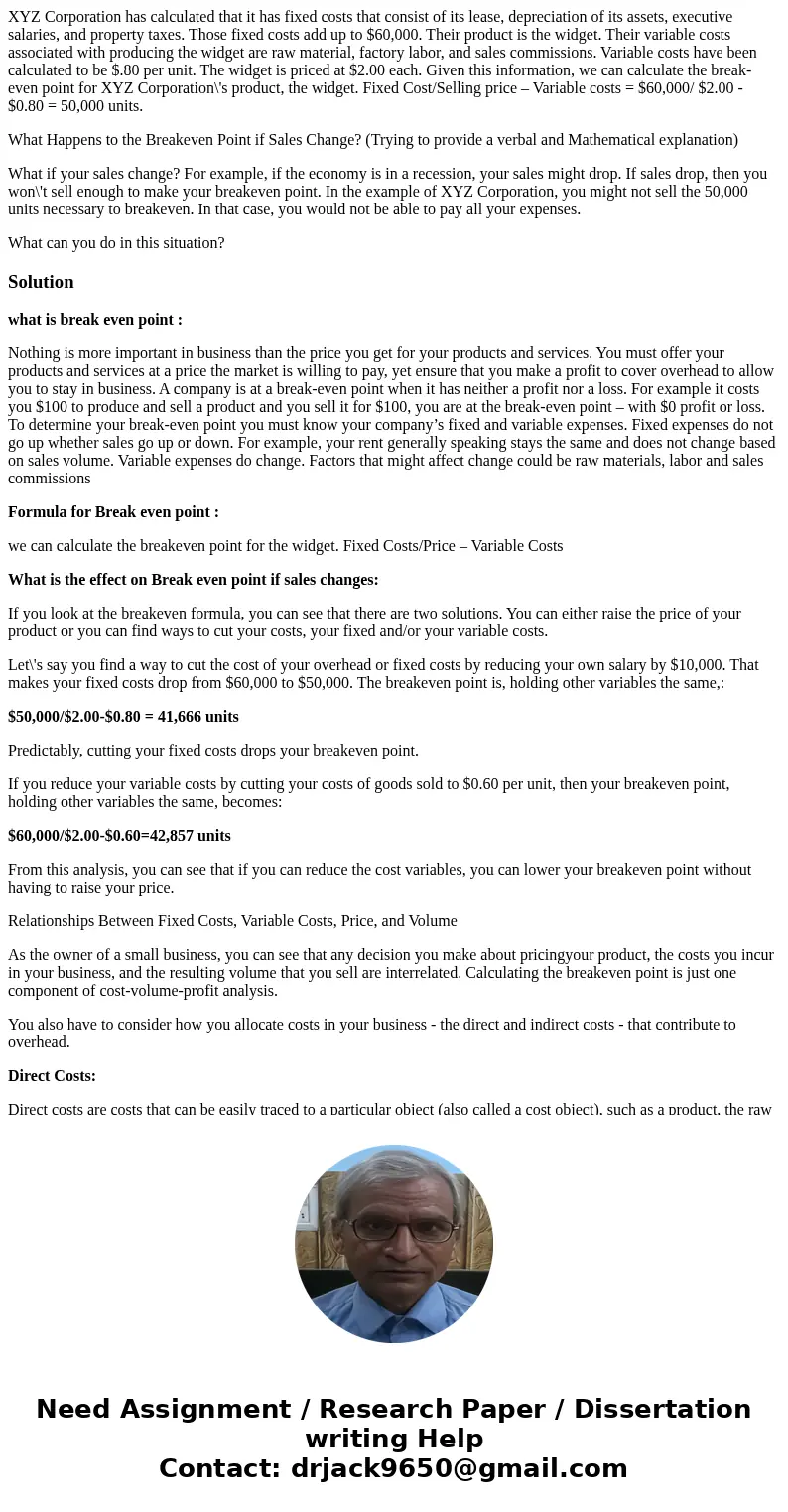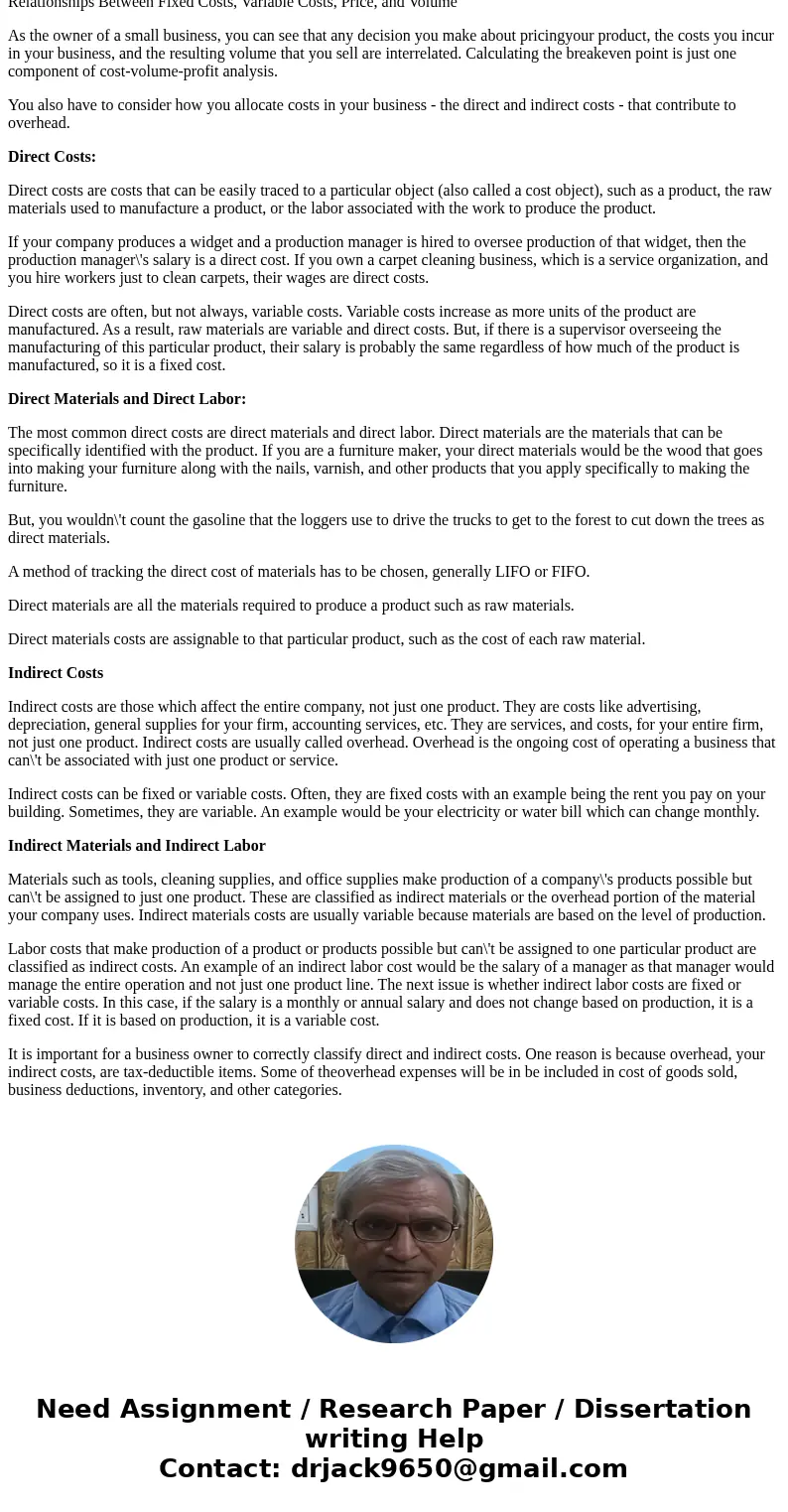XYZ Corporation has calculated that it has fixed costs that
XYZ Corporation has calculated that it has fixed costs that consist of its lease, depreciation of its assets, executive salaries, and property taxes. Those fixed costs add up to $60,000. Their product is the widget. Their variable costs associated with producing the widget are raw material, factory labor, and sales commissions. Variable costs have been calculated to be $.80 per unit. The widget is priced at $2.00 each. Given this information, we can calculate the break-even point for XYZ Corporation\'s product, the widget. Fixed Cost/Selling price – Variable costs = $60,000/ $2.00 - $0.80 = 50,000 units.
What Happens to the Breakeven Point if Sales Change? (Trying to provide a verbal and Mathematical explanation)
What if your sales change? For example, if the economy is in a recession, your sales might drop. If sales drop, then you won\'t sell enough to make your breakeven point. In the example of XYZ Corporation, you might not sell the 50,000 units necessary to breakeven. In that case, you would not be able to pay all your expenses.
What can you do in this situation?
Solution
what is break even point :
Nothing is more important in business than the price you get for your products and services. You must offer your products and services at a price the market is willing to pay, yet ensure that you make a profit to cover overhead to allow you to stay in business. A company is at a break-even point when it has neither a profit nor a loss. For example it costs you $100 to produce and sell a product and you sell it for $100, you are at the break-even point – with $0 profit or loss. To determine your break-even point you must know your company’s fixed and variable expenses. Fixed expenses do not go up whether sales go up or down. For example, your rent generally speaking stays the same and does not change based on sales volume. Variable expenses do change. Factors that might affect change could be raw materials, labor and sales commissions
Formula for Break even point :
we can calculate the breakeven point for the widget. Fixed Costs/Price – Variable Costs
What is the effect on Break even point if sales changes:
If you look at the breakeven formula, you can see that there are two solutions. You can either raise the price of your product or you can find ways to cut your costs, your fixed and/or your variable costs.
Let\'s say you find a way to cut the cost of your overhead or fixed costs by reducing your own salary by $10,000. That makes your fixed costs drop from $60,000 to $50,000. The breakeven point is, holding other variables the same,:
$50,000/$2.00-$0.80 = 41,666 units
Predictably, cutting your fixed costs drops your breakeven point.
If you reduce your variable costs by cutting your costs of goods sold to $0.60 per unit, then your breakeven point, holding other variables the same, becomes:
$60,000/$2.00-$0.60=42,857 units
From this analysis, you can see that if you can reduce the cost variables, you can lower your breakeven point without having to raise your price.
Relationships Between Fixed Costs, Variable Costs, Price, and Volume
As the owner of a small business, you can see that any decision you make about pricingyour product, the costs you incur in your business, and the resulting volume that you sell are interrelated. Calculating the breakeven point is just one component of cost-volume-profit analysis.
You also have to consider how you allocate costs in your business - the direct and indirect costs - that contribute to overhead.
Direct Costs:
Direct costs are costs that can be easily traced to a particular object (also called a cost object), such as a product, the raw materials used to manufacture a product, or the labor associated with the work to produce the product.
If your company produces a widget and a production manager is hired to oversee production of that widget, then the production manager\'s salary is a direct cost. If you own a carpet cleaning business, which is a service organization, and you hire workers just to clean carpets, their wages are direct costs.
Direct costs are often, but not always, variable costs. Variable costs increase as more units of the product are manufactured. As a result, raw materials are variable and direct costs. But, if there is a supervisor overseeing the manufacturing of this particular product, their salary is probably the same regardless of how much of the product is manufactured, so it is a fixed cost.
Direct Materials and Direct Labor:
The most common direct costs are direct materials and direct labor. Direct materials are the materials that can be specifically identified with the product. If you are a furniture maker, your direct materials would be the wood that goes into making your furniture along with the nails, varnish, and other products that you apply specifically to making the furniture.
But, you wouldn\'t count the gasoline that the loggers use to drive the trucks to get to the forest to cut down the trees as direct materials.
A method of tracking the direct cost of materials has to be chosen, generally LIFO or FIFO.
Direct materials are all the materials required to produce a product such as raw materials.
Direct materials costs are assignable to that particular product, such as the cost of each raw material.
Indirect Costs
Indirect costs are those which affect the entire company, not just one product. They are costs like advertising, depreciation, general supplies for your firm, accounting services, etc. They are services, and costs, for your entire firm, not just one product. Indirect costs are usually called overhead. Overhead is the ongoing cost of operating a business that can\'t be associated with just one product or service.
Indirect costs can be fixed or variable costs. Often, they are fixed costs with an example being the rent you pay on your building. Sometimes, they are variable. An example would be your electricity or water bill which can change monthly.
Indirect Materials and Indirect Labor
Materials such as tools, cleaning supplies, and office supplies make production of a company\'s products possible but can\'t be assigned to just one product. These are classified as indirect materials or the overhead portion of the material your company uses. Indirect materials costs are usually variable because materials are based on the level of production.
Labor costs that make production of a product or products possible but can\'t be assigned to one particular product are classified as indirect costs. An example of an indirect labor cost would be the salary of a manager as that manager would manage the entire operation and not just one product line. The next issue is whether indirect labor costs are fixed or variable costs. In this case, if the salary is a monthly or annual salary and does not change based on production, it is a fixed cost. If it is based on production, it is a variable cost.
It is important for a business owner to correctly classify direct and indirect costs. One reason is because overhead, your indirect costs, are tax-deductible items. Some of theoverhead expenses will be in be included in cost of goods sold, business deductions, inventory, and other categories.


 Homework Sourse
Homework Sourse